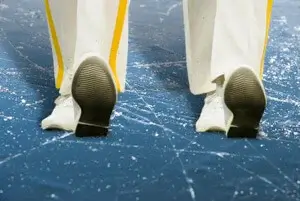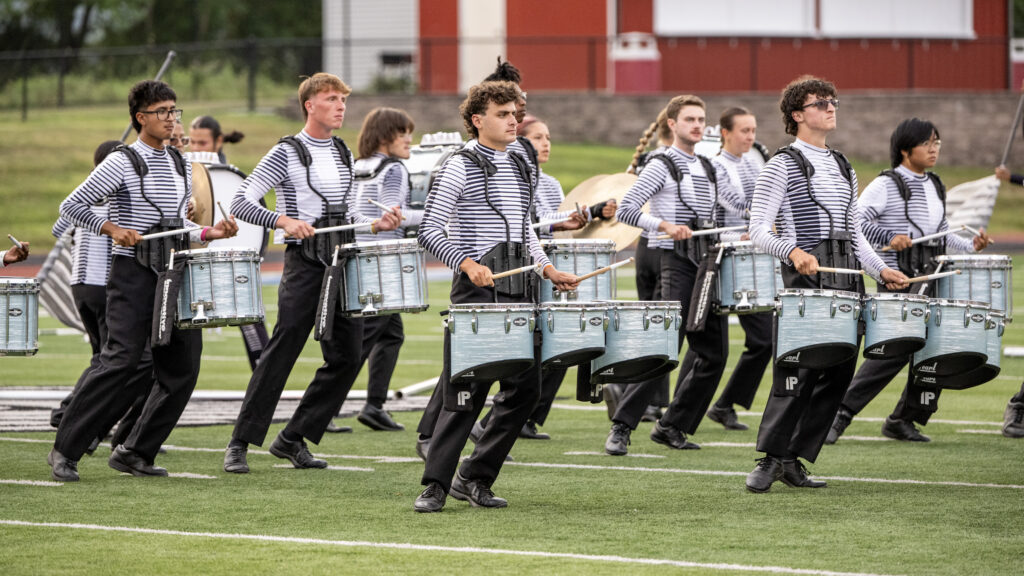
By now, many of us have all but overdosed on figure skating, the one component of the Winter Olympics that is most comparable to drum corps; if for no other reason than in each, people move around the performance surface in an unparalleled display of art and athleticism, while hardly anyone understands how they’re judged.
Several years back, I used to interview top figure skaters for a publication that has since ceased to exist, a victim somewhat of the Internet, an increasingly endless fount of instant information that has forever changed how we get our news and entertainment content. As a result of this, I was commissioned to write a book, the creatively titled “The Story of Figure Skating.” Published by William Morrow, it was honored by the bimonthly library journal Voice of Youth Advocates as one of the top nonfiction books of the year for young readers, and it had the shelf life of a mayfly.
Because of my background, my editor thought that with the Olympics coming to a close in a few days, I should take this opportunity to compare figure skating to drum corps. But then, he also thought it would be a good idea to explore the influence of the drum corps activity on the Super Bowl a few weeks ago, and as a result, I think the Internet lost its innocence.
But with figure skating highlighting Olympic events this week and the drum corps season a mere four months away, there may be no better time to attempt to find similarities between figure skating and the activity we all love so much. So here we go.
Let’s try venues: Figure skating competitions used to be held outdoors. Even Winter Olympic events were held outside.
(No, I can’t come up with anything there.)
Costumes: Ah, there we go. Skaters often wear flamboyant outfits that distract from their skating, with oodles of beads, feathers, and bright colors that don’t exist in nature. Sometimes, even the female skaters wear such outfits as well.
(Nope…still not connecting.)
At this year’s Winter Olympics, the men’s silver medalist, Evgeny Plushenko, launched an ongoing diatribe against the figure skating judges because he didn’t win with a program he insisted was technically superior over his main competitor, Evan Lysacek.
(Okay…this isn’t easy. I’ll continue to look.)
In the “old days” of figure skating, the judges looked at the skaters’ performances and put down a number that often seemed to be pulled out of the air. The strange thing about the system was how the placements of each judge interacted with the scores of all the other judges. This was the old ordinal system that sometimes resulted in one skater dropping two or more positions after just one other skater’s scores from each judge were announced. Today, judges not only watch each performance, but make electronic notes on computers that takes them back to each and every jump so they can study it on a screen and make sure every little bobble and mistake is duly noted, while also making sure the proper number of rotations on each jump were met for maximum credit.
In our “old days,” we had the tick system, where judges watched every performance and made little marks (ticks) on the sheets on their clipboards, allowing the tabulator to make sure every little bobble and mistake was duly noted. So, as you can see, there’s never been a valid comparison to figure skating regarding judging.
The judging system for figure skating seems to change every few years while the International Skating Union attempts to figure out the best and most equitable way to rank and rate. Skaters that figure it out after each major change then adjust their programs to maximize the scores they’ll receive. They’re duly credited not necessarily because they’ve presented the most entertaining programs, but because they’ve learned how to work the judging system.
(Not yet.)
Figure skating has Zambonis. Drum corps doesn’t. Well, even this year, Olympic figure skating events didn’t either. Instead of using Zambonis, the Canadian Winter Olympics committee decided the events would use three electric ice resurfacers made by another company. And one-by-one, all three machines failed. The Vancouver organizers discovered that despite the promises of how electricity would modernize the events and point the way to the future, they had to fly in good old-fashioned acoustic Zambonis to do the trick.
(And you’ll agree that with even an active imagination, we’ve got nothing comparable to use as an object lesson.)
Figure skating fans often complain about the music the skaters choose for their programs.
(Boy, this isn’t getting any easier.)
Skaters draw for performance position within prior established blocks. Skaters who go on early frequently complain that judges hold back scores until later in the contest.
(Maybe I should just quit now.)
No … Let’s get back to the Internet. Today, figure skating fans have taken the concept of armchair quarterbacking to new levels. Numerous Web sites give the fans a chance to spout off on anything and everything that creates passion within their souls. This may include their opinions on how the sport should move forward, what’s wrong with it, who got ripped off, who’s getting too much credit, what music the skaters should be performing to, how skater “ABC” would compare to skater “XYZ” from 20 years ago, who was the best silver medalist in Olympic history, who had the cleanest performance, who had the best costume, how the sound in the arena wasn’t great, how a skater looked at a training session six months before an actual competition, how one manufacturer of skates and blades is better than another, which skaters increased their scores the most during a season, why there aren’t any skating contests in South Dakota, how did a skater drop from being champion the year before to finishing off the podium, how skaters could bring the audience into their performance even before the judging starts, how skaters rely on certain techniques and gimmicks to project effect, how the compulsory requirements from earlier years should be brought back, how too many skaters skate alike, etc., etc. etc.
(Drum corps fans, on the other hand, seem united in consensus and a common goal. So once again the comparisons fall flat.)
My editor, in trying to stimulate my brain cells for this article, pointed out that on page 206 of my book, I wrote, “When a skating performance flows from beginning to end, it turns into something far beyond a mere routine—it turns into a work of art.”
It’s that accomplishment of achieving the cherished status of art that makes us smile, tickles our fancy and fills us with a sense of satisfaction, wonder, amazement and bliss. It gives us something we can take great pleasure and pride in. Ultimately it makes us happy.
Well FINALLY, that’s it!
(And frankly, that’s reason enough to continue to enjoy both.)

Michael Boo was a member of the Cavaliers from 1975-1977. He has written about the drum corps activity for more than a quarter century and serves as a staff writer for various Drum Corps International print and Web projects. Boo has written for numerous other publications and has published an honors-winning book on the history of figure skating.





